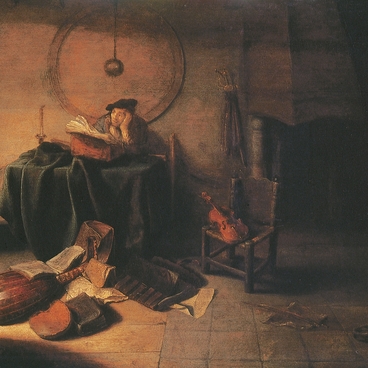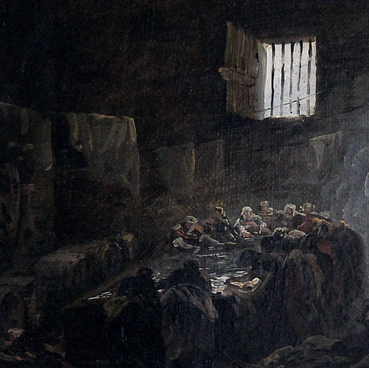Jan Victors lived for 57 years, and the greater part of his life he worked as a painter in Amsterdam, his native town. Only in his last years financial troubles made him find other occupations overseas. For instance, he was a ‘ziekentrooster’ (‘comforter of the sick’) in Indonesia; his duties included attending gravely sick patients and administering aid to them, reading them sermons written by official clergy.
However, themes like health, sickness and medical treatment were a distinguishing feature of the author’s entire artistic career. A few masterpieces of the Dutch Golden Age, such as A Market Scene with a Quack at his Stall or The Dentist with an Audience, deserve a special mention.
The Serpukhov Museum of History and Art possesses one out of the four extant copies of A Street Healer. The exhibit found its way to the collection as a result of a picture exchange with the Pushkin State Museum of Fine Arts.
The artist used oil paints to depict a city square on canvas. It is a scene of action for a wandering healer and 13 other characters. Children and adults were captured in theatrical postures.
Jan Victors’ attitude to traveling charlatans is quite accurately described by a European saying, ‘He lies like a dentist, ” which has an equivalent in Russian (it can be roughly translated as “to charm toothache away”). The agony in the face of one patient and his clenched fists clearly attest to the quality of the healer’s services.
By the way, other Dutch painters, such as Hieronymus Bosch, Pieter Bruegel the Elder and Lucas van Leyden, were of the same opinion about ‘marketplace’ healing.
The creator of this tableau made a special emphasis on the onlooking public, rather than on the trickster and his female accomplice. One woman is so enthralled by the medical performance that she is unaware that a boy is pinching grapes from her basket.
Here lies the moralizing meaning of the composition. Grapes were both a rare product in those parts and a symbol of Christian grace. From the author’s viewpoint, people seeking pennyworth entertainment were losing spiritual values but did not even take heed of their loss.
Some art experts speculate that Jan Victors was probably a pupil at the art studio of Rembrandt Harmenszoon van Rijn. However, there is only one piece of evidence that there was some connection between the two painters: a 1722 cadaster record. Style elements have been referred to as indirect proof that the renowned master could have had influence on his apprentice: For instance, warm hues, fabrics with complicated patterns, small space between figures, and precise gestures. All that is present in Haman Begging Queen Esther for Mercy or The Anointment of David.
However, themes like health, sickness and medical treatment were a distinguishing feature of the author’s entire artistic career. A few masterpieces of the Dutch Golden Age, such as A Market Scene with a Quack at his Stall or The Dentist with an Audience, deserve a special mention.
The Serpukhov Museum of History and Art possesses one out of the four extant copies of A Street Healer. The exhibit found its way to the collection as a result of a picture exchange with the Pushkin State Museum of Fine Arts.
The artist used oil paints to depict a city square on canvas. It is a scene of action for a wandering healer and 13 other characters. Children and adults were captured in theatrical postures.
Jan Victors’ attitude to traveling charlatans is quite accurately described by a European saying, ‘He lies like a dentist, ” which has an equivalent in Russian (it can be roughly translated as “to charm toothache away”). The agony in the face of one patient and his clenched fists clearly attest to the quality of the healer’s services.
By the way, other Dutch painters, such as Hieronymus Bosch, Pieter Bruegel the Elder and Lucas van Leyden, were of the same opinion about ‘marketplace’ healing.
The creator of this tableau made a special emphasis on the onlooking public, rather than on the trickster and his female accomplice. One woman is so enthralled by the medical performance that she is unaware that a boy is pinching grapes from her basket.
Here lies the moralizing meaning of the composition. Grapes were both a rare product in those parts and a symbol of Christian grace. From the author’s viewpoint, people seeking pennyworth entertainment were losing spiritual values but did not even take heed of their loss.
Some art experts speculate that Jan Victors was probably a pupil at the art studio of Rembrandt Harmenszoon van Rijn. However, there is only one piece of evidence that there was some connection between the two painters: a 1722 cadaster record. Style elements have been referred to as indirect proof that the renowned master could have had influence on his apprentice: For instance, warm hues, fabrics with complicated patterns, small space between figures, and precise gestures. All that is present in Haman Begging Queen Esther for Mercy or The Anointment of David.

